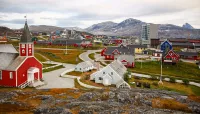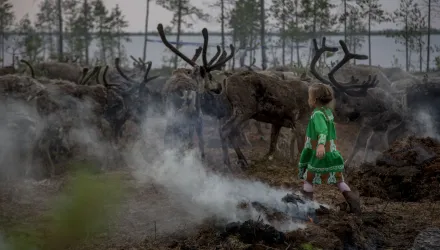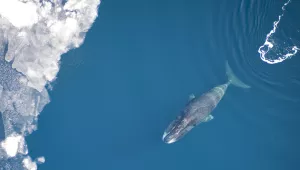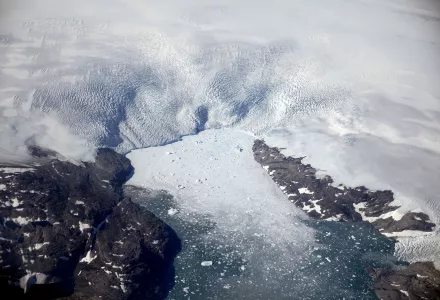
The recent media blitz about Greenland—and President Trump’s interest in it — has overshadowed a much more important story about the world’s largest island and the impact of its melting ice on people living in coastal communities around the world.
Polar ice sheets are shrinking rapidly, fueled by rising global temperatures both in the atmosphere and ocean. The Greenland ice sheet alone has the potential to raise global sea levels by an astonishing 23 feet were it to melt away completely. Slowing the rate of ice loss is therefore of utmost concern not only for coastal communities, but to avoid shocks to global economies, infrastructure, military installations, and the livelihoods of billions of people. Some experts now propose that sea level rise should be a policy metric in the United Nations Framework Convention on Climate Change.
This spring, the Belfer Center’s Arctic Initiative, the Woods Hole Oceanographic Institution, and Rethink Energy Florida co-hosted a webinar on the status of Greenland’s ice sheet, the implications for the United States and the world, and opportunities to slow down future melting and sea level rise.
Watch the Recording
Read on for key takeaways identified by the panelists, Sarah Das, Polar and Climate Scientist at the Woods Hole Oceanographic Institution; Rafe Pomerance, Senior Policy Fellow at Woodwell Climate Research Center; and Margaret Williams, Senior Fellow at the Belfer Center’s Arctic Initiative.
Why is Greenland losing ice?
The Greenland ice sheet loses mass mainly through melting and calving processes. Melting of Greenland’s ice sheet and glaciers is increasing in response to warming from above and below. As global air temperatures rise—something that is happening fastest in the Arctic—warm air over the ice sheet exposes more areas to melting temperatures. In addition, atmospheric warming is also raising ocean temperatures, and there are signs that warm ocean currents around Greenland are melting back the submerged front of many glaciers there.
Arctic warming also results in changes to ice dynamics, affecting the speed at which glaciers move from the interior of the ice sheet towards the coast. Meltwater on the surface can flow to the bottom of the ice sheet through cracks and holes, resulting in the ice sheet sliding more quickly over its bed towards the sea. Increased calving rates reduce mass and can also further increase movement along the ice sheet margin, as loss of ice around the edges of the ice sheet diminishes the forces holding back ice further in the interior.
Currently, southern Greenland is losing ice the fastest—about 234 billion tons per year. Overall, Greenland is melting about seven times faster than it was 30 years ago.
Why is the Arctic warming faster than other parts of the globe?
There are several reasons why the Arctic is warming faster. One of the most influential is that as sea ice melts, it exposes darker ocean water beneath, which has a lower albedo (reflectivity) than ice, leading to increased absorption of solar radiation and further warming. This process creates a self-reinforcing cycle where reduced Arctic sea ice cover accelerates warming, contributing to more ice melt and so on.
How does the melting of the Greenland ice sheet impact the rest of the world?
The melting of Greenland's ice sheet has far-reaching consequences for global climate stability and human well-being, one of the most important being its contribution to global sea level rise. This contributes to increased rates of coastal flooding and inundation worldwide, posing a threat to approximately 90 million people in the United States alone, and hundreds of millions of people worldwide. In addition, flooding associated with rising sea level creates health risks, for example by contaminating water supplies and promoting the spread of waterborne diseases. The costs of all of these impacts are substantial, as businesses, governments, and individuals are forced to invest in infrastructure and property protection and adaptation measures.
Research indicates that the melting of Greenland’s ice sheet and the influx of fresh water into the ocean may also be contributing to the slowing of important ocean currents that distribute heat around the planet, even in the Southern Hemisphere. Changes to the Atlantic Meridional Overturning Circulation (AMOC), also known as the “global ocean conveyer belt,” could mean colder climates for Europe, drier conditions in the tropics, and wetter, warmer weather patterns in the Southern Hemisphere. Disruptions in major ocean currents also impact marine ecosystems, including commercially valuable fisheries. Changing ocean currents also alter regional climates and contribute to changes in extreme weather events such as droughts and floods. All of these impacts, from sea level rise, weather and climate, and food security, have important consequences for global economic stability.
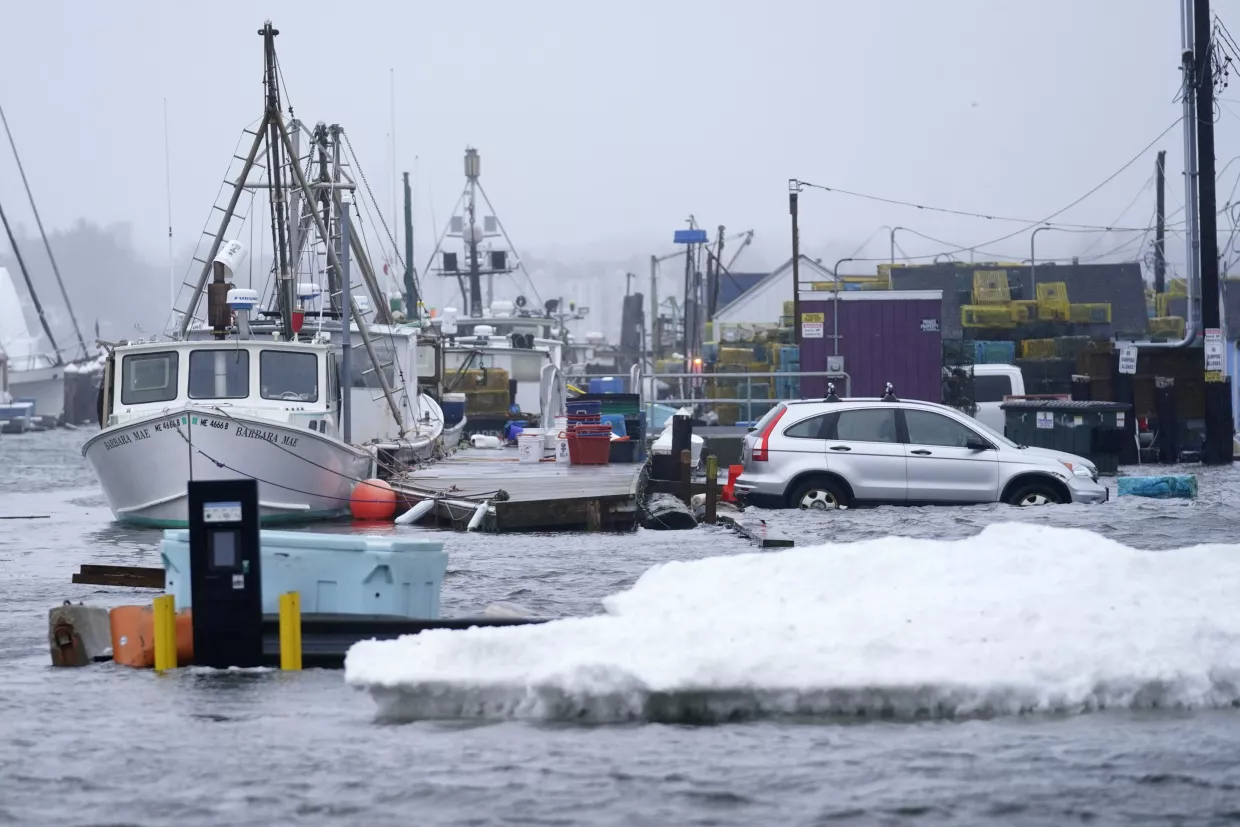
How much does Greenlandic melt contribute to sea level rise? What other factors are contributing to sea level rise?
Global sea level rise is primarily a result of increased melting of glaciers and ice sheets worldwide, as well as warming ocean temperatures causing seawater to expand in volume, in a process called thermal expansion.
The Greenland ice sheet is responsible for 20 percent of current sea level rise. The IPCC projects that by 2100, Greenland could contribute 3.1 to 10.6 inches (8 to 27 cm) to global sea level, and the melting of Antarctic ice may add another 1.2 to 11 inches (3 to 28 cm). Predictions of future sea level rise must take many factors into consideration.
Coastal erosion and loss of sediment from increased storms and land use changes can also amplify the impacts of coastal flooding on communities and ecosystems.
Why is sea level rise not uniform?
In many coastal regions, the rate of sea level rise is greater than the global average due to regional and local processes. An important process impacting densely populated cities worldwide is subsidence, when land sinks or settles due to natural geologic processes and human-made factors such as pumping water out of aquifers. Other factors, such as changes in ocean currents near shore, can also affect local sea level. The combined effects of coastal subsistence and rising seas worsen flooding and threaten densely populated cities worldwide.
How does the melting of the Greenland ice sheet affect Greenlanders?
In Greenland, the loss of ice leads to local land rise and sediment accumulation, causing harbors to become shallower, which complicates shipping and transportation essential for communities to remain supplied and connected with one another. Travel hazards are exacerbated by more icebergs in fjords and coastal waters near glaciers (as well as on the high seas near Greenland), posing risks to navigation. Infrastructure damage is another concern, as rapid changes in the environment threaten roads and buildings due to increased flooding and permafrost thaw. The melting ice also disrupts traditional hunting practices, leading to food insecurity as sea ice becomes less stable and animal migration patterns change. This threatens the cultural heritage and livelihoods of Indigenous communities that rely on subsistence hunting.
On the other hand, the melting ice exposes mineral resources, offering potential economic opportunities. However, these projects are controversial due to environmental concerns and are still far from being commercially viable. While mining could help Greenland achieve economic independence, it remains a contentious issue among residents and requires careful consideration of its long-term impacts.
Will the Greenland ice sheet regenerate?
The Greenland ice sheet is unlikely to regenerate, as it would require the climate to not just stop warming, but to cool significantly.
What can be done to slow the melting of the Greenland ice sheet and sea level rise?
The best thing society can do to prevent further irreversible melting of the Greenland ice sheet and slow the continued rise of sea levels is to, first and foremost, reduce the burning of fossil fuels which are the primary contributors to planetary warming greenhouse gases—particularly carbon dioxide and methane. There also may be a role for carbon capture technologies that remove carbon dioxide from the atmosphere and store it underground or in the ocean for long periods of time, but many of these are prohibitively expensive, are still being tested, and it is unclear whether they can be deployed at scale or, if they are, whether they will cause unintended environmental damage.
Note: Thanks to Kenneth Kostel at Woods Hole Oceanographic Institution, Kim Ross at ReThink Energy Florida, and Elizabeth Hanlon at the Belfer Center for their editorial support.




